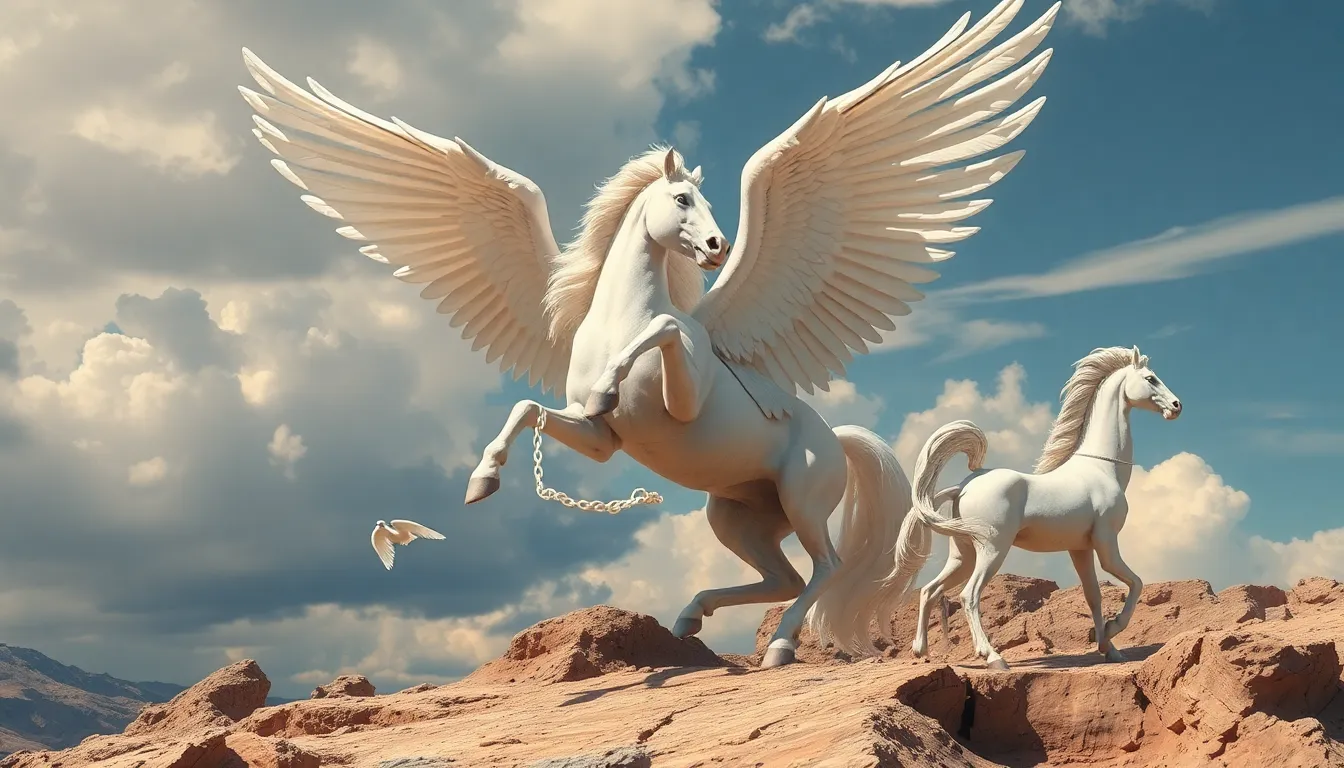The Relationship Between Pegasus and Other Winged Creatures in Myth
I. Introduction
In Greek mythology, Pegasus stands out as one of the most iconic winged creatures, embodying both beauty and power. This magnificent horse, with wings that allow it to soar through the skies, captures the imagination and symbolizes various themes, including inspiration and divine guidance. Winged creatures, in general, hold a prominent place in the mythologies of many cultures, serving as symbols of freedom, transcendence, and the connection between the earthly and the divine. This article explores the connections between Pegasus and other mythological beings, delving into their origins, symbolism, and cultural significance.
II. The Origins of Pegasus
Pegasus, often depicted as a beautiful white horse with magnificent wings, has a rich origin story in Greek mythology. According to myth, Pegasus was born from the blood of the Gorgon Medusa when she was slain by the hero Perseus. His birth symbolizes the idea that beauty and inspiration can arise from chaos and destruction.
In the context of Greek mythology, Pegasus is closely associated with the hero Bellerophon. Bellerophon, who was tasked with slaying the Chimera, was able to ride Pegasus after taming him with the help of a golden bridle given to him by the goddess Athena. Their partnership highlights the bond between humans and divine creatures, showcasing themes of bravery, heroism, and the quest for glory.
III. Symbolism of Pegasus
Pegasus is rich in symbolism, representing various concepts across different narratives:
- Representation of Inspiration and Poetic Creativity: Pegasus is often associated with the Muses, the goddesses of the arts, particularly poetry. His flight represents the elevation of the human spirit and the pursuit of artistic expression.
- Association with the Heavens and Divine Guidance: As a creature of the skies, Pegasus serves as a bridge between the mortal world and the divine, symbolizing the guidance that comes from higher powers.
- Contrast with Other Winged Creatures: Unlike many other winged beings in mythology, which often embody chaos or destruction, Pegasus embodies purity, inspiration, and the nobility of the human spirit.
IV. Comparative Analysis of Winged Creatures
Winged creatures abound in various mythologies, each with distinctive characteristics and meanings. Here are some notable examples:
A. Overview of Notable Winged Creatures from Different Mythologies
- Griffin (Greek and Persian): A creature with the body of a lion and the head and wings of an eagle, the griffin symbolizes strength, protection, and divine power. It was often seen as a guardian of treasures and sacred sites.
- Garuda (Hindu and Buddhist): Known as the king of birds, Garuda is a powerful figure in Hindu mythology, representing speed, martial prowess, and the ability to conquer evil. He is often depicted as a vehicle for the god Vishnu.
- Thunderbird (Native American): In various Native American cultures, the Thunderbird is a supernatural bird that brings thunder and rain, symbolizing power and strength. It is often seen as a protector of the people and a symbol of creation.
B. Similarities and Differences in Characteristics and Symbolism
While all these winged creatures share the ability to fly, their symbolism varies greatly:
- Pegasus embodies inspiration and artistic creativity.
- The griffin symbolizes strength and protection.
- Garuda represents power and martial force.
- The Thunderbird embodies creation and natural forces.
V. The Role of Winged Creatures in Mythological Narratives
Winged creatures often serve crucial functions in mythological stories, acting as messengers, guardians, or symbols of power:
- Messengers: Creatures like Hermes’ winged sandals or Pegasus can act as messengers between gods and humans.
- Guardians: Many winged beings serve to protect sacred spaces or treasures, as seen with the griffin.
- Symbols of Power: Their flight often signifies divine authority or the ability to transcend earthly limitations.
The interaction between these creatures and human characters often serves to highlight moral and ethical teachings, emphasizing virtues like courage, wisdom, and responsibility.
VI. Cultural Impact of Pegasus and Winged Creatures
Throughout history, Pegasus and other winged creatures have left a profound impact on art, literature, and popular culture:
- Influence on Art: Pegasus has been depicted in countless works of art, from ancient pottery to Renaissance paintings, symbolizing beauty and inspiration.
- Literature: The figure of Pegasus appears in various literary works, representing the muse and the spark of creativity.
- Modern Interpretations: Contemporary adaptations in movies, books, and video games continue to explore the themes associated with Pegasus, often reimagining him in new contexts.
The enduring legacy of these winged creatures highlights their relevance in contemporary storytelling, showcasing their universal themes.
VII. Thematic Connections Between Pegasus and Other Winged Beings
Exploring common themes among winged creatures reveals deeper insights into human aspirations and fears:
- Freedom: Flight symbolizes the ultimate freedom, transcending earthly limitations.
- Transcendence: Winged beings often represent the connection between the mundane and the divine.
- Duality: Many winged creatures embody dualities, such as beauty and danger, creativity and chaos.
The role of flight as a metaphor in mythology reflects the human desire to rise above challenges and achieve greatness, serving as a powerful symbol of hope and aspiration.
VIII. Conclusion
In summary, the relationship between Pegasus and other winged creatures in mythology reveals a rich tapestry of symbolism and meaning. From their origins and roles in mythological narratives to their profound cultural impact, these beings continue to inspire and captivate the human imagination. Pegasus, with its associations with inspiration and divine guidance, stands as a testament to the enduring significance of winged creatures in mythology and their lasting legacy in human culture.
Reflecting on the themes of freedom, transcendence, and duality, we see how these narratives resonate with our own aspirations and fears. The presence of winged creatures in mythology serves as a reminder of our desire to soar above the ordinary and connect with something greater than ourselves.




